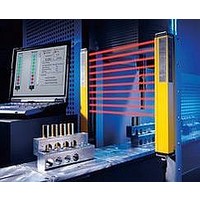F39-EU1E Omron, F39-EU1E Datasheet - Page 57

F39-EU1E
Manufacturer Part Number
F39-EU1E
Description
F3S-B OPTIONAL PROGRAMMING KIT
Manufacturer
Omron
Datasheet
1.F39-EU1E.pdf
(865 pages)
Specifications of F39-EU1E
Leaded Process Compatible
No
Peak Reflow Compatible (260 C)
No
Light Curtain Type
Safety
Lead Free Status / RoHS Status
Contains lead / RoHS non-compliant
Lead Free Status / RoHS Status
Contains lead / RoHS non-compliant
- Current page: 57 of 865
- Download datasheet (35Mb)
Courtesy of Steven Engineering, Inc.-230 Ryan Way, South San Francisco, CA 94080-6370-Main Office: (650) 588-9200-Outside Local Area: (800) 258-9200-www.stevenengineering.com
➑ Troubleshooting
The following table can be used for troubleshooting when Relay
operation is not normal. Refer to this table when checking the circuit
and other items.
If checking the circuit reveals no abnormality, and it appears that the
fault is caused by a Relay, contact your OMRON representative. (Do
not disassemble the Relay. Doing so will make it impossible to identify
the cause of the problem.)
A Relay is composed of various mechanical parts, including a coil,
contacts, and iron core. Among these, problems occur most often with
the contacts, and next often with the coil.
(1) Operation fault
(2) Release fault
(3) Coil burning
(4) Contact welding
(5) Contact failure
(6) Abnormal contact
(7) Humming
consumption
Fault
http://www.ia.omron.com/
1. Incorrect coil rated voltage selected
2. Faulty wiring
3. Input signal not received
4. Power supply voltage drop
5. Circuit voltage drop (Be careful in particular of
6. Rise in operating voltage along with rise in ambient
7. Coil disconnection
1. Input signal OFF fault
2. Voltage is applied to the coil by a sneak current
3. Residual voltage by a combination circuit such as a
4. Release delay due to parallel connection of coil and
5. Contact welding
1. Unsuitable voltage applied to coil
2. Incorrect rated voltage selected
3. Short-circuit between coil layers
1. Excessive device load connected (insufficient
2. Excessive switching frequency
3. Short-circuiting of load circuit
4. Abnormal contact switching due to humming
5. Expected service life of contacts reached
1. Oxidation of contact surfaces
2. Contact abrasion and aging
3. Terminal and contact displacement due to faulty
1. Unsuitable Relay selection
2. Insufficient consideration of device load (especially
3. No contact protection circuit
4. Insufficient withstand voltage between adjacent
1. Insufficient voltage applied to coil
2. Excessive power supply ripple (DC)
3. Incorrect coil rated voltage selected
4. Slow rise in input voltage
5. Abrasion in iron core
6. Foreign material between moveable iron piece and
high-current devices operated nearby or wired at a
distance.)
operating temperature (especially for DC)
semiconductor circuit
capacitor
contact capacity)
motor, solenoid, and lamp loads)
contacts
iron core
handling
Probable cause
These problems, however, mostly occur as a result of external factors
such as methods and conditions of operation, and can generally be
prevented by means of careful consideration before operation and by
selecting the correct Relays.
The following table shows the main faults that may occur, their
probable causes, and suggested countermeasures to correct them.
(c)Copyright OMRON Corporation 2007 All Rights Reserved.
1. Select the correct rated voltage.
2. Check the voltage between coil terminals.
3. Check the voltage between coil terminals.
4. Check the power supply voltage.
5. Check the circuit voltage.
6. Test individual Relay operation.
7.
1. Check the voltage between coil terminals.
2. Check the voltage between coil terminals.
3. Check the voltage between coil terminals.
4. Check the voltage between coil terminals.
5. For contact welding, see fault (4).
1. Check the voltage between coil terminals.
2. Select the correct rated voltage.
3. Recheck the operating atmosphere.
1. Check the load capacity.
2. Check the number of switches.
3. Check the load circuits.
4. For humming, see fault (7).
5. Check the contact ratings.
1.
2. The expected service life of the contacts has been
3. Be careful of vibration, shock, and soldering
1. Select the correct Relay.
2. Select the correct devices.
3. Add a circuit such as a spark quenching circuit.
4. Select the correct Relay.
1. Check the voltage between coil terminals.
2. Check the ripple percentage.
3. Select the correct rated voltage.
4. Make supplemental changes to circuit.
5. The expected service life has been reached.
6. Remove the foreign material.
reached.
operations.
For coil burning, see fault (3).
For disconnection due to electrical corrosion,
check the polarity being applied to the coil voltage.
Recheck the operating atmosphere.
Select the correct Relay.
Countermeasures
Precautions for All Relays
C-15
Related parts for F39-EU1E
Image
Part Number
Description
Manufacturer
Datasheet
Request
R

Part Number:
Description:
Pair Of Flat Mounting Brackets (transmitter & Receiver)
Manufacturer:
Omron

Part Number:
Description:
Pair Of Protective Shrouds (transmitter & Receiver)
Manufacturer:
Omron

Part Number:
Description:
G6S-2GLow Signal Relay
Manufacturer:
Omron Corporation
Datasheet:

Part Number:
Description:
Compact, Low-cost, SSR Switching 5 to 20 A
Manufacturer:
Omron Corporation
Datasheet:

Part Number:
Description:
Manufacturer:
Omron Corporation
Datasheet:










